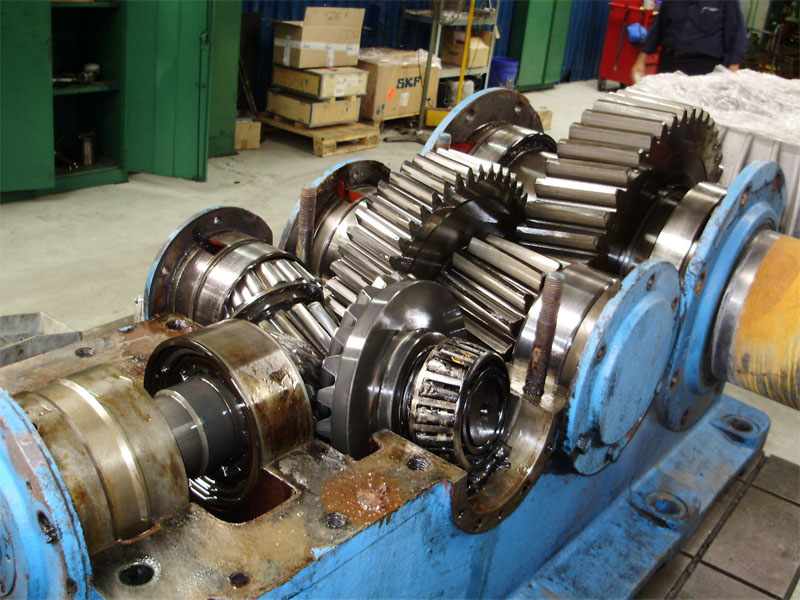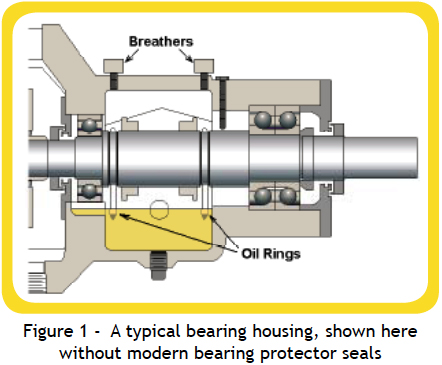
Adding Grease to Electric Motor Bearings
Adding Grease to Electric Motor Bearings
Electric motors utilizing double shielded or double sealed bearings, which are typically of the lubricated-for-life design, usually do not require regreasing. On the other hand, all others, those being open or single shielded or sealed bearings, should be re-lubricated periodically to replace grease that has deteriorated, leaked away, or become contaminated. Generally, operating conditions will dictate the relubrication interval required.
All greases deteriorate at some rate, even under moderate operating conditions. The principal causes are oxidation, excessive oil bleeding, and mechanical working. At high temperatures, oil evaporation may also be a factor. Oxidation eventually increases the oil viscosity and hardens the soap. Some oil bleeding is desirable, but too much reduces the ability of the grease to maintain an effective lubrication film. Mechanical working, or shearing, may change grease properties such as consistency, making the grease less suited to the application. Excessive oil evaporation may harden the grease. Deterioration often ends in hard, dry, deposits that can neither lubricate bearings nor protect them against contaminants.
Operating and other factors that influence re-lubrication frequency include: temperature, continuity of service, quantity of grease in housing, size and speed of bearing, vibration, exposure to contaminants, effectiveness of seals, and the grease’s suitability for the particular service.
Re-greasing Intervals
1. High grease temperatures increase the oxidation rate, doubling it for every 18°F (10°C) rise above 120°F (49°C). High temperature also tends to increase the rate of bleeding and evaporation of the oil. Additionally, grease tends to soften as temperatures increase and may become fluid enough to leak out of housings. Other things being equal, operating at high temperatures will require more frequent relubrication, or the use of a high temperature grease.
2. Continuity of service means hours of service per day or other time unit. A grease continuously subjected to deteriorating factors will need replacement more often than the grease in a bearing used only occasionally.
3. A large quantity of grease in a properly designed housing will last longer than a small quantity in a proportionally smaller housing. The small quantity will be reworked more often than an equal portion of the large quantity and will not benefit from reserve capacity (including more oil and additives). Under moderate conditions, however, a small quantity of grease in a factory lubricated sealed or shielded bearing may last a long time, perhaps several years.
4. The Dn value of a bearing (bore diameter in mm x speed in rpm) is proportional to the linear speed of the rolling elements and may be used as a guide to determine relubrication frequency. In bearings operating in the Dn range of 150,000 to 200,000 or more, grease in the path of the elements is severely worked and heated. Such bearings require more frequent relubrication even with correctly selected grease that does not slump excessively. Some bearing manufacturers use Ndm (speed in rpm x pitch diameter of the bearing) instead of Dn. This method produces somewhat higher reference values, but considers the effect of rolling element size and the bearing’s cross section dimensions.
5. Vibration causes grease to feed more freely into the rolling elements’ path, where it is worked and heated excessively. This reduces grease life, especially in high speed bearings. Churning and shearing in bearings “mills down” some greases, which become fluid enough to leak excessively. Either factor means more frequent relubrication.
6. More frequent relubrication usually will be required if the grease is marginal in any major characteristic — oxidation, bleeding, pumpability, antiwear and antirust properties, or mechanical stability.
It is not a simple matter to decide when and how often to relubricate. Generally, the decision reflects experience and the machine builder’s and grease supplier’s recommendations. Relubrication intervals for most rolling element bearings range from two weeks to two years although for many it is once a year during scheduled maintenance shutdowns. At the lower extreme, bearings running at or near their speed limits may require relubrication as often as every six to eight hours.
It is important to regrease on an appropriate schedule so that the old grease remains soft enough for purging. Bearing or equipment manufacturers recommend relubrication intervals based on operating conditions and type of grease. Typically, light to medium duty electric motors, that run continuously, will require at least annual relubrication. Reduce the relubrication interval by half for every 10°C above the nominally recommended temperatures.
Two commonly used methods for determining the correct relubrication frequency follow.
1. The first utilizes the following equation:
Frequency (hours) = {[14,000,000/(shaft rpm)(Bearing ID)1/2 mm] — [(4)(Bearing ID) mm]}{F bearing type}{F temperature} {F contamination} where,
F bearing type = 1.0 for spherical or thrust bearing, 5.0 for cylindrical bearing, 10.0 for ball bearing
F temperature = 1.0 for under 160°F, divide by two for every 20°F above 160°F
F contamination = 0.1 to 1.0 depending on the level of contamination—motor bearings normally 1.0
* Formula above taken from the Practical Handbook of Machinery Lubrication Second Edition plus added factors for temperature and contamination from field experience.
2. The second method utilizes the following graph for determining relubrication frequencies:



